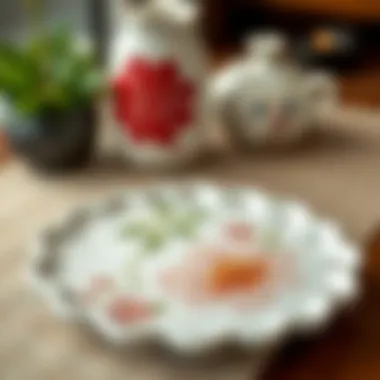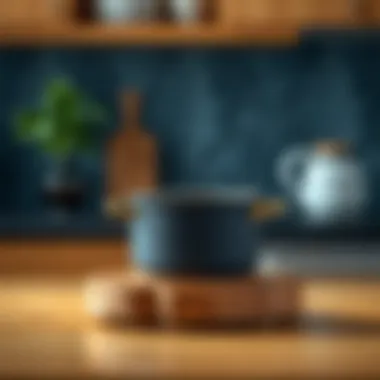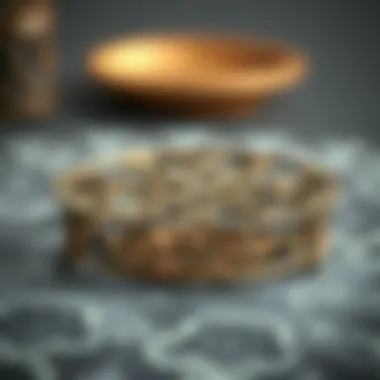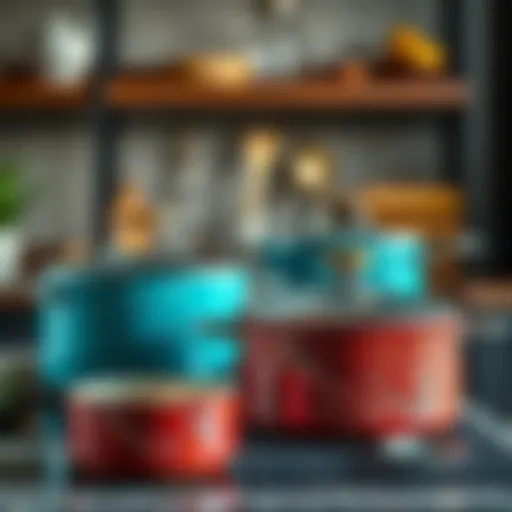Trivets for Hot Food: Materials, Design, and Trends


Intro
When it comes to creating a warm and inviting dining experience, the humble trivet often goes unnoticed. Yet, this kitchen tool plays a vital role in both functionality and aesthetics. In a world where style meets practicality, understanding what trivets bring to the table is essential for homeowners looking to elevate their culinary engagements.
Trivets come in various shapes, sizes, and materials, each tailored to meet different needs and preferences. Whether you are a seasoned chef or a casual cook, selecting the right trivet can enhance your cooking experience while adding a touch of personality to your table setting. As we journey through this guide, we will explore the fascinating world of trivets—highlighting their materials, designs, and how they harmonize safety with style. Let's dive into the intricate tapestry of trivets for hot food.
Furniture Styles and Trends
Modern vs. Traditional: Understanding the Aesthetics
In today's kitchens, the aesthetic appeal of trivets often mirrors larger furniture trends. Modern trivets boast sleek designs, often crafted from materials like silicone or stainless steel, that reflect minimalist philosophies. These contemporary pieces are not just practical; they make a statement, blending seamlessly with the clean lines and open spaces of modern design.
Conversely, traditional trivets often embrace a more ornate approach. Crafted from wood, wrought iron, or ceramics, these pieces are rich in craftsmanship and history. They add rustic charm to the dining table, reminding us of the cozy kitchens of yesteryears. Homeowners might find that the choice between modern and traditional trivets depends on their overall kitchen theme, where each trivet can either echo the sleekness of modernity or the warmth of tradition.
Color and Material Trends: What's In and What's Out
With styles continuously evolving, the colors and materials of trivets also follow suit. Presently, natural materials such as bamboo and cork are gaining popularity due to their eco-friendliness and sustainability. Bright colors and geometric patterns are also trending, injecting vibrancy into kitchen spaces. On the other hand, muted tones and natural finishes seem to recede in favor of bolder choices, reflecting a desire for self-expression in the kitchen.
When selecting a trivet, it’s wise to consider both the color palette that represents your kitchen's mood and the material’s heat resistance capabilities. Heatproof contributes to the durability and longevity of the trivet, ensuring it holds up to the demands of daily cooking.
"A well-chosen trivet is more than just a heat barrier; it’s a design element that can elevate your dining experience."
Epilogue
Understanding trivets for hot food is about recognizing their dual role in safety and design. As we have explored the dynamic world of trivets—from modern to traditional styles and the trends influencing material choices—it's clear that these tools are indispensable for any kitchen. By making a thoughtful selection, homeowners can not only protect their surfaces but also enhance the overall aesthetic of their dining experiences.
For more information on kitchen design and trends, consider visiting resources such as Wikipedia or Britannica.
Exploring the essential role of trivets in your kitchen is just the beginning. With the right knowledge, you can elevate not only your culinary adventures but also the atmosphere of your home.
Preface to Trivets
Trivets serve a crucial role in both functionality and aesthetics within a kitchen. These small, often overlooked items are essential for protecting surfaces from heat damage. In today's kitchens, where design meets practicality, understanding the importance of trivets can elevate not just the cooking process, but also the overall dining experiences.
Not only do trivets come in various materials and designs, but they also reflect personal style. When you think of your dining table or kitchen counter filled with family recipes or trendy culinary creations, the right trivet can balance style with utility. Selecting the appropriate trivet means considering its heat resistance, durability, and how well it blends into your existing decor.
The satisfaction derived from placing a steaming dish on a beautifully designed trivet enlightens a dining experience—in essence, it says good food deserves a good presentation. By appreciating the subtleties of trivets, homeowners, designers, and DIY enthusiasts can enhance their culinary activities while ensuring safety.
Historical Background
Historically, trivets were often simple metal stands or frames designed to hold hot pots and pans. Their roots can be traced back to ancient times when pots were made of clay and needed to be elevated off the fire or hot surfaces. A distinct array of materials have arisen throughout history, reflecting regional craftsmanship and societal norms regarding cooking and serving.
In Medieval Europe, iron trivets became commonplace, known for their ability to withstand high heat. They transformed from merely functional items to symbols of artistry and craftsmanship, often featuring ornate designs. In contrast, Asian cultures used stone or ceramic trivets that resonated with their culinary traditions, focusing on aesthetics along with practicality.
The evolution of trivets illustrates how a mere kitchen tool can encapsulate history, culture, and innovation—a true testament to human creativity.
Purpose and Functionality
The primary purpose of a trivet is to provide a protective barrier against heat, shielding surfaces from potential burns or heat damage. Unlike a cloth mat, which may trap moisture and potentially damage fine furniture, a trivet allows air to circulate, preventing buildup of heat.
Here’s a breakdown of a trivet's key functional roles:
- Heat Defense: The most fundamental role is to guard tabletop surfaces from hot cookware.
- Stability: A trivet provides a stable platform for holding heavy pots, ensuring dishes don’t tip over or slide.
- Aesthetic Addition: Beyond utility, trivets enhance the visual appeal of your table setting. A matching trivet can complement dinnerware or serve as a statement piece itself.
- Versatility: Some manufacturers design trivets that can also be used as serving trays, allowing for dual functionality in serving.
By choosing the right trivet, you ensure both practicality and style mesh seamlessly in your culinary realm.
Material Types for Trivets
When it comes to ensuring that hot dishes can be safely placed on various surfaces, the choice of materials in trivets plays a critical role. By understanding the different materials available, homeowners can make an informed decision based on aesthetics, functionality, and durability. This section breaks down each material type, detailing their specific benefits and considerations.


Ceramic Trivets
Ceramic trivets add a touch of elegance to any table setting. Often characterized by their intricate designs and glaze finishes, these trivets serve not just a utilitarian purpose but also enhance the visual appeal of a dining table. Typically, ceramic is quite heat-resistant, making it a practical option for holding hot pots or dishes without damage. However, one must be cautious, as ceramic can be prone to chipping or cracking if dropped.
In a practical sense, ceramic trivets are lightweight and easy to clean, able to withstand frequent use. They can come in a variety of shapes and colors, allowing for personalization that fits different kitchen styles. All in all, ceramic trivets strike a good balance between form and function, although they may need to be handled with care to avoid accidental breakage.
Metal Trivets
Metal trivets are often favored for their durability and sturdiness. Let’s break them down further into the three main types: Copper, Cast Iron, and Stainless Steel. Each offers its own set of characteristics, advantages, and drawbacks.
Copper
Copper trivets are known for their excellent thermal conductivity. This means that they quickly and efficiently absorb heat, ensuring that surfaces underneath stay protected from scorching temperatures. A notable characteristic of copper is its rich, warm color that can brighten up any kitchen.
While copper’s aesthetic appeal is undeniable, it does require regular maintenance to keep its shine. Additionally, copper can tarnish and may react with acidic foods, which is something to consider when preparing certain dishes. Nonetheless, for those who prioritize both style and effectiveness, copper trivets remain a popular choice among culinary enthusiasts.
Cast Iron
Cast iron trivets are a powerhouse in the world of kitchen tools. Renowned for their durability and ability to retain heat, they provide steady support for hot cookware. The dense nature of cast iron means that these trivets can endure high temperatures without warping over time.
However, cast iron does come with certain considerations. It can be heavier than other materials, making it somewhat cumbersome to handle. Additionally, cast iron must be seasoned to maintain its non-stick properties and prevent rusting, which requires some commitment to upkeep. Still, for the dedicated home chef, cast iron trivets bring both functionality and a rustic charm to the table.
Stainless Steel
When it comes to modern kitchen aesthetics, stainless steel trivets embody sleek sophistication. Known for being rust-resistant and exceptionally strong, they hold up extremely well under various conditions. Stainless steel trivets don’t absorb heat like other materials, which helps to protect surfaces underneath from getting scorched.
One of the standout features of stainless steel is its compatibility with various kitchen themes, from contemporary to industrial. However, while they are durable, their surface can be prone to scratches, which might detract from their shiny new look over time. That said, the low-maintenance requirements and enduring quality of stainless steel often make it a go-to choice for many.
Wooden Trivets
Wooden trivets present a natural and warm aesthetic. They can vary in style, from beautifully carved pieces to minimalist designs. Their insulating properties help protect surfaces from extreme heat, making them quite effective for their intended purpose. Moreover, they can add an organic touch to the kitchen or dining table, which can be particularly meaningful in homes that focus on rustic or homely decor.
However, wooden trivets do require particular care; they should be oiled regularly to prevent cracking and splitting, especially in humid or dry environments. Additionally, they cannot be washed in the dishwasher, which makes maintenance slightly more labor-intensive. Still, their charm and eco-friendliness appeal to many.
Silicone and Other Modern Materials
Modern advancements have introduced silicone trivets to the market, which offer a multitude of benefits. These trivets are heat-resistant and can withstand temperatures ranging from -40°F to 500°F, making them incredibly versatile. One of the great things about silicone is its flexibility, meaning you can easily store these trivets without worrying about breakage.
Another unique feature of silicone is its non-slip surface, which is great for preventing pots from sliding around when placed on them. While they come in various colors and shapes, some may argue that they lack the aesthetic appeal associated with traditional materials. Nonetheless, for practicality and ease of use, silicone trivets are hard to beat and are becoming increasingly popular in modern kitchens.
Design Considerations
When it comes to selecting a trivet for your kitchen, design considerations play a crucial role beyond mere aesthetics. The right trivet can seamlessly blend functionality with style, enhancing not just practicality but also the visual appeal of your space. Homeowners, designers, and enthusiasts alike should ponder these factors to ensure their chosen trivets serve their intended purpose while also contributing to the overall decor of the kitchen or dining area.
Aesthetic Appeal
Trivets today are available in a myriad of designs, ranging from traditional to modern and everything in between. Choosing a trivet based on aesthetic appeal means selecting one that complements the existing decor style. For instance, a rustic wooden trivet can add warmth and charm to a farmhouse kitchen, while a sleek stainless steel option lends a contemporary touch to a minimalist setup.
The connection between a trivet's design and the room's theme cannot be understated. An intricate ceramic trivet may serve as a conversation starter at dinner parties, while colorful silicone trivets might jazz up a children's dining table. Here are some common design themes to consider:
- Traditional: Often features ornate designs or classic patterns.
- Modern: Sleek lines, simple shapes, and monochromatic colors.
- Eclectic: A mix of textures and vibrant colors; perfect for creative kitchens.
Tip: Don't shy away from using trivet designs that reflect personal interests, such as themes inspired by nature, art, or culture.
Size and Shape Variations
Size and shape are essential considerations when selecting trivets, as they dictate not only aesthetic but also functionality. Trivets come in various sizes, from small individual coasters to larger, more elaborate designs suitable for serving platters.
- Standard Square or Round: Generally versatile and fit well with most settings.
- Novelty Shapes: Trivets shaped like leaves, animals, or other creative forms can add personality to the table.
In smaller kitchens, opting for compact trivets can be ideal. Alternatively, larger, more striking designs can serve as focal points on expansive dining tables. The dimensions of the trivet should accommodate the cookware or serving dishes it will support, ensuring stability and safety.
Customization Options
Today’s trivet market also features plenty of customization options that allow individuals to truly make a design their own. Custom trivets can reflect personal tastes, family heritage, or even logos for those in the retail or hospitality sector.
When considering customization:
- Materials: Choose from various materials that align with personal style and functionality.
- Engraving or Printing: Some companies offer engraving services for names, special dates, or meaningful quotes.
- Color Choices: Custom colors can enhance the trivet to suit kitchen color schemes without compromising on practicality.
Custom trivets offer an opportunity to showcase individuality while ensuring safety and functionality, fostering a unique dining experience.
In summary, the design of a trivet impacts everything from its practical use to its contribution to your home. Whether you're seeking a functional piece that resonates with your decor or a stylish statement accessory, taking design considerations seriously ensures that your trivet is not just an item of utility but a harmonious addition to your space.
Safety Aspects of Using Trivets
Understanding the safety aspects of using trivets is crucial for both protecting your surfaces and ensuring an enjoyable cooking and dining experience. As simple as they appear, trivets play an essential role in preventing heat damage, which can lead to costly repairs or replacements of furniture, especially in a household setting. This section dives into two key areas: heat resistance ratings and avoiding damage to surfaces.
Heat Resistance Ratings
When purchasing a trivet, it's imperative to consider its heat resistance rating. Different materials offer varying levels of protection against high temperatures. For instance, a cast iron trivet can withstand extreme heat thanks to its dense composition, making it perfect for heavy pots taken directly from the stovetop. On the other hand, a silicone trivet might tolerate heat up to a certain limit but can melt if exposed to temperatures beyond its threshold.
Moreover, understanding the heat resistance ratings helps in preventing accidents in the kitchen. Always check for manufacturer specifications to ensure that the trivet can handle the temperature range of your cookware, especially if you’re transitioning directly from the oven to the table.
Key Points on Heat Resistance:
- Material Matters: Choose trivets made from materials specifically designed to resist high temperatures.
- Check Ratings: Look for clear heat resistance ratings provided by the manufacturer when selecting a trivet.
- Avoid Overlap: Ensure your trivet’s size can accommodate your cookware without the edges hanging over or being too small.
Investing in a quality trivet not only ensures safety but also extends the lifespan of your kitchen surfaces.
Avoiding Damage to Surfaces
Trivets exist for a reason—primarily to protect your surfaces from burns and scratches that arise from hot cookware. However, a trivet’s effectiveness extends beyond mere presence; its proper use is equally critical.
Here are some practical tips to help avoid damage to your surfaces:
- Use the Right Size: Ensure the trivet is appropriately sized for your cookware. A trivet that is too small may not adequately shield your countertop or table.
- Keep Clean: Dirt or debris between the trivet and your surfaces could scratch or damage them. Regular cleaning of trivets is vital.
- Avoid Direct Contact with Heat: Position your pots and pans properly on the trivet to prevent the edges from touching the surfaces directly.
- Material Selection: Avoid trivets made from materials that may scratch or melt easily, which could lead to damage if misused.
Keeping these guidelines in mind can prevent minor mishaps that could lead to significant issues. The right trivet in combination with careful usage ensures your surroundings stay safe and intact, enhancing the overall cooking and dining experience.
By paying attention to both heat parameters and surface protection, homeowners, designers, and DIY enthusiasts can elevate their use of trivets, combining functionality and style without compromising safety.
Trivets in Contemporary Home Design
Trivets have made quite a name for themselves beyond their basic utilitarian role in the kitchen. In today's homes, they don’t just protect surfaces from hot pots and pans; they also serve as eye-catching decor elements. This evolution reflects wider trends in home design, where functionality meets aesthetics. Each trivet can be considered an accessory that complements the overall theme of a room, resonating with the homeowners' personal style while providing practical benefits.
Trivets as Decorative Accents
Imagine a kitchen or dining table adorned with sleek, beautifully designed trivets. These items can be conversation starters, elevating the ambiance of any meal. The beauty of trivets lies in their variety - from hand-painted ceramics that invoke a rustic charm to minimalist metal constructions that suit a modern aesthetic.
With the right trivet, one can effortlessly enhance the style quotient of a dining setup. For example, a vibrant, floral-patterned ceramic trivet might perfectly complement a wooden table laden with a hearty casserole, while a geometric metal design can add a contemporary flair against a simpler backdrop.
“Choosing the right trivet is akin to selecting artwork for your home. It should speak to your personality and blend with your design ethos.”
The use of trivets as decorative accents is more than a trend; it's about creating an environment that feels cohesive and thoughtfully planned. They can incorporate color palettes or material choices echoing the surrounding decor. For those with a knack for design, customizing a trivet with personal artwork or inscriptions can add a uniquely personal touch.
Integrating Trivets with Table Settings
When it comes to table settings, trivets play a multi-faceted role. Not only do they protect the table, but they also help set the stage for a meal. Their placement can influence the immediate perception of the dining experience. Imagine a crisp white tablecloth adorned with a bold, handcrafted wooden trivet. It acts not just as a protective platform but also as an anchor for the visual elements of the meal - perhaps a roast or a colorful vegetable dish.


Thoughtful integration of trivets with table settings involves considering the entire dining experience:
- Color Coordination: Choose a trivet that matches or complements dinnerware colors.
- Height and Size Compatibility: Ensure the trivet’s dimensions suit the serving dishes, allowing for an organized presentation.
- Layering Textures: Pair different materials – a glossy ceramic trivet can harmonize nicely with fabric or wooden tables, adding depth to the visual appeal.
In a way, trifles like trivets remind us of the simple joy of gathering around the table, sharing warmth, both in temperature and in camaraderie. They underscore that while style is important, the essence of dining together is equally celebrated.
By considering both their functional and decorative roles, homeowners can elevate their dining spaces significantly, turning everyday meals into memorable gatherings.
Maintenance and Care Guidelines
Caring for your trivets is crucial not just for their longevity but also for maintaining their functional and aesthetic appeal. Proper maintenance helps in retaining their appearance and increases their effectiveness when safeguarding your surfaces from hot cookware. Let’s delve into the specifics of caring for different types of trivets and how best to store them after use.
Cleaning Materials for Different Types
The cleaning method largely depends on the material of the trivet. Each material has its own quirks and requires specific care to preserve its beauty and function.
- Ceramic trivets: These are easy to wash, typically just needing a soft sponge and warm, soapy water. Abrasive cleaners should be avoided, as they can scratch the surface.
- Metal trivets: To clean metal trivets, like copper or stainless steel, a gentle detergent suffices. For tarnished copper, a mixture of lemon juice and baking soda effectively restores its luster.
- Wooden trivets: Wooden trivets must be handled with care. A damp cloth is often enough, but be cautious not to soak the wood. Periodically applying mineral oil can help maintain its finish and prevent cracking.
- Silicone trivets: These are generally dishwasher safe, making them very easy to clean. If hand washing, hot water with mild soap is sufficient.
Keeping the right tools handy for cleaning trivets saves lots of time. Have a dedicated sponge for your trivets to ensure you aren’t transferring greasy residues from cookware.
Storing Trivets Properly
How you store your trivets can dramatically affect their lifespan and usability. Proper storage not only prevents damage but also avoids clutter in your kitchen. Here are some guidelines:
- Stacking Trivets: If your trivets are stackable, storing them stacked saves space. However, place a soft cloth or paper towel between them to prevent scratching.
- Wall Mounting: For larger or decorative trivets, consider displaying them on walls. This not only clears countertop space but also adds character to your kitchen decor.
- Specialty Storage Boxes: If you have an assortment of trivets, consider using a designated box or drawer to keep them together.
A little thought in how you care for and store your trivets will go a long way. The more effort you put into their maintenance, the more you can enjoy the benefits they provide during your culinary adventures.
Trends in Trivet Usage
In the dynamic world of kitchen design, trivets are gaining a spotlight not just for their utility, but for their ability to blend with current style trends. Observing the trends in trivet usage provides insights into what consumers desire today. It isn’t merely about functionality anymore; today's designers and homeowners are looking for pieces that align with aesthetic sensibilities and environmental consciousness. This section will delve into two significant trends: minimalist design and sustainability in material choices.
Minimalist Trends
Minimalism has become more than a passing trend in home design; it reflects a broader philosophy that resonates with many. In recent years, trivets have embraced minimalist aesthetics, showcasing simple lines, neutral palettes, and an overall understated elegance. Such designs draw attention with subtlety rather than flamboyance, making them fit seamlessly into various kitchen styles.
- Clean Lines: Minimalist trivets often feature geometric shapes that add a modern touch without overwhelming the space.
- Color Palette: Soft, muted colors or classic monochrome schemes dominate this trend, allowing trivets to merge with countertops and dining settings effortlessly.
- Functionality: Even in their simplicity, minimalist trivets are designed to perform well, ensuring they provide the heat resistance needed without compromising on style.
This design philosophy aligns with the modern homeowner’s desire for uncluttered spaces, where each item serves a purpose while contributing to an overall harmonious environment. By integrating minimalist trivets into their kitchens, individuals express a taste that values form and function equally.
Sustainability in Material Choices
In the age of climate awareness, the choice of materials has shifted dramatically. More people are gravitating towards sustainable products that boast both longevity and eco-friendliness. Trivets made from renewable resources or recycled materials are becoming prevalent, making it easy for environmentally conscious consumers to make informed choices.
- Natural Materials: Wooden trivets, especially those sourced from sustainably managed forests, are popular for their aesthetic and environmental benefits. The texture and warmth of wood can enhance the homey feel of any kitchen.
- Recycled Materials: Some manufacturers are now producing trivets made from recycled metals or plastics, which reduces landfill waste and resource consumption.
- Biodegradable Options: With advances in technology, some silicone and composite materials offer biodegradable alternatives, appealing to those looking for a guilt-free solution.
The trend towards sustainable trivet materials not only showcases an awareness of environmental impact but also invites homeowners to reflect their values through their kitchen items. As we place increasing importance on sustainability, choosing a trivet becomes part of a larger narrative about ecological responsibility and mindful living.
"A home that reflects its owner’s principles can create a deeper connection with the space, enhancing both comfort and conscience."
By understanding these trends in trivet usage, readers can make choices that align with current design philosophies while promoting a sustainable lifestyle. This knowledge empowers consumers to select pieces that harmonize with their personal values and aesthetic tastes.
End
In wrapping up our exploration of trivets, it’s apparent that these often-overlooked kitchen tools play a vital role in both functionality and aesthetics. Trivets are not merely placeholders; they are integral to ensuring safety, preserving surfaces, and adding visual charm to dining setups. Considering the variety of materials and designs available today, homeowners, designers, and enthusiasts alike can choose options that seamlessly blend with their kitchens and dining spaces.
Recap of Key Points
To summarize the key elements discussed throughout the article:
- Historical Significance: Trivets have evolved from ancient supports for hot pots to contemporary kitchen necessities.
- Material Diversity: From ceramic and metal to wood and silicone, each material offers unique characteristics that impact both safety and style.
- Design Choices: Aesthetic appeal, size, and customization are crucial in selecting the right trivet for individual needs.
- Safety Considerations: Proper heat resistance and surface protection practices are vital to prevent damage in your culinary space.
- Trends in Usage: The rise of minimalism and sustainability emphasizes the importance of mindfulness in selecting trivets for modern homes.
Final Thoughts on Selection and Use
When it comes to selecting a trivet, one must think about how it fits into the overall kitchen and dining experience. A well-chosen trivet does more than protect surfaces; it can also elevate the presentation of meals—an eye-catching trivet can transform a simple dinner into a more impressive affair. Consider the functionality you’re looking for, but do not forget the aesthetic aspect. There's a wide world of options, and choosing the right one can be both a practical decision and a delightful opportunity for self-expression in your culinary space.
As trends shift towards minimalism and eco-friendly materials, exploring options that reflect sustainability can not only enhance the dining experience but also support a healthier planet. In sum, whether you're a culinary novice or a seasoned chef, the right trivet serves as an anchor in the shared experience of cooking and dining.















